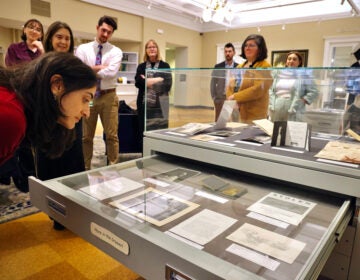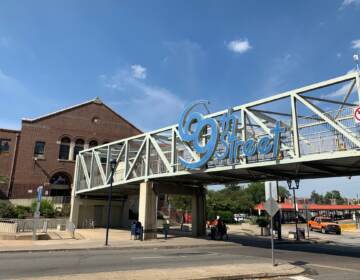How Mural Arts is helping artists get paid during the pandemic
Philly’s Mural Arts Program is finding ways to get artists work and to get them paid, despite concerns over looming budget cuts to arts funding and the city’s arts office.
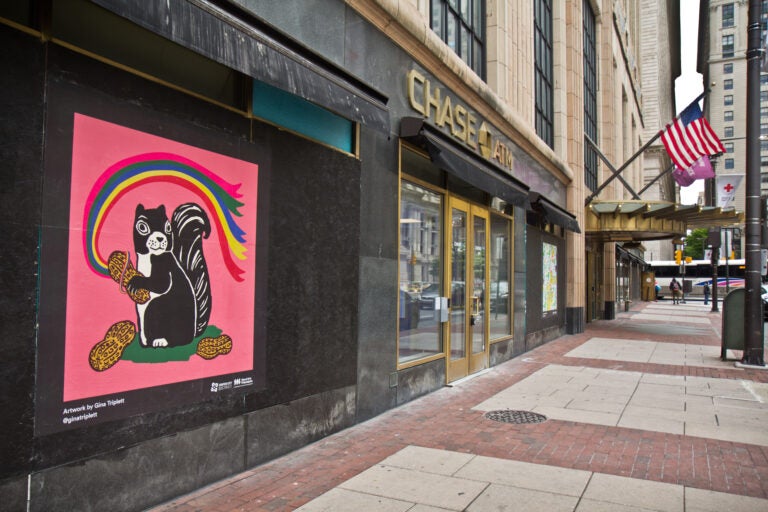
The Mural Arts Program installed works on storefronts boarded up due to coronavirus lockdowns in Center City. This cheerful squirrel across from City Hall is by artist Gina Triplett. (Kimberly Paynter/WHYY)
Philadelphia’s Center City District businesses had been closed for over a month, since Pennsylvania’s stay-at-home orders and nonessential business closures took effect, when colorful artworks showing moments of joy started to pop up throughout the neighborhood.
Twenty eight pieces — from a white dove in a sea of daisies to a man grinning while riding his bike with no hands — have been installed in front of 10 small businesses in Center City, from restaurants to retail.
That was thanks to a partnership between Center City District and Philly’s Mural Arts Program — which despite concerns over looming budget cuts to arts funding and the city’s arts office — is finding ways to get artists work, and to get them paid.
“We thought this is wonderful because [the boarded-up business] were looking so bleak, and art is a sign. It can be a harbinger that things will turn around, a message of hope in a way,” said Mural Arts Executive Director Jane Golden. “It meant we could put money in the pocket of artists, which I think is a critical thing to be doing right now.”
Golden is not sure how long the pieces — made by 12 local artists — will be on display for — but they made sure to use durable material: parachute cloths applied with acrylic gel, which they use for many of their large murals across the city.
She added that what she, and the team of artists and crew members installing the work, hear the most in reaction to storefront artwork is “thank you.”
“It makes me feel that our notion that the arts is important, especially in times of distress, is really an important one, and one we cannot discount,” Golden said.
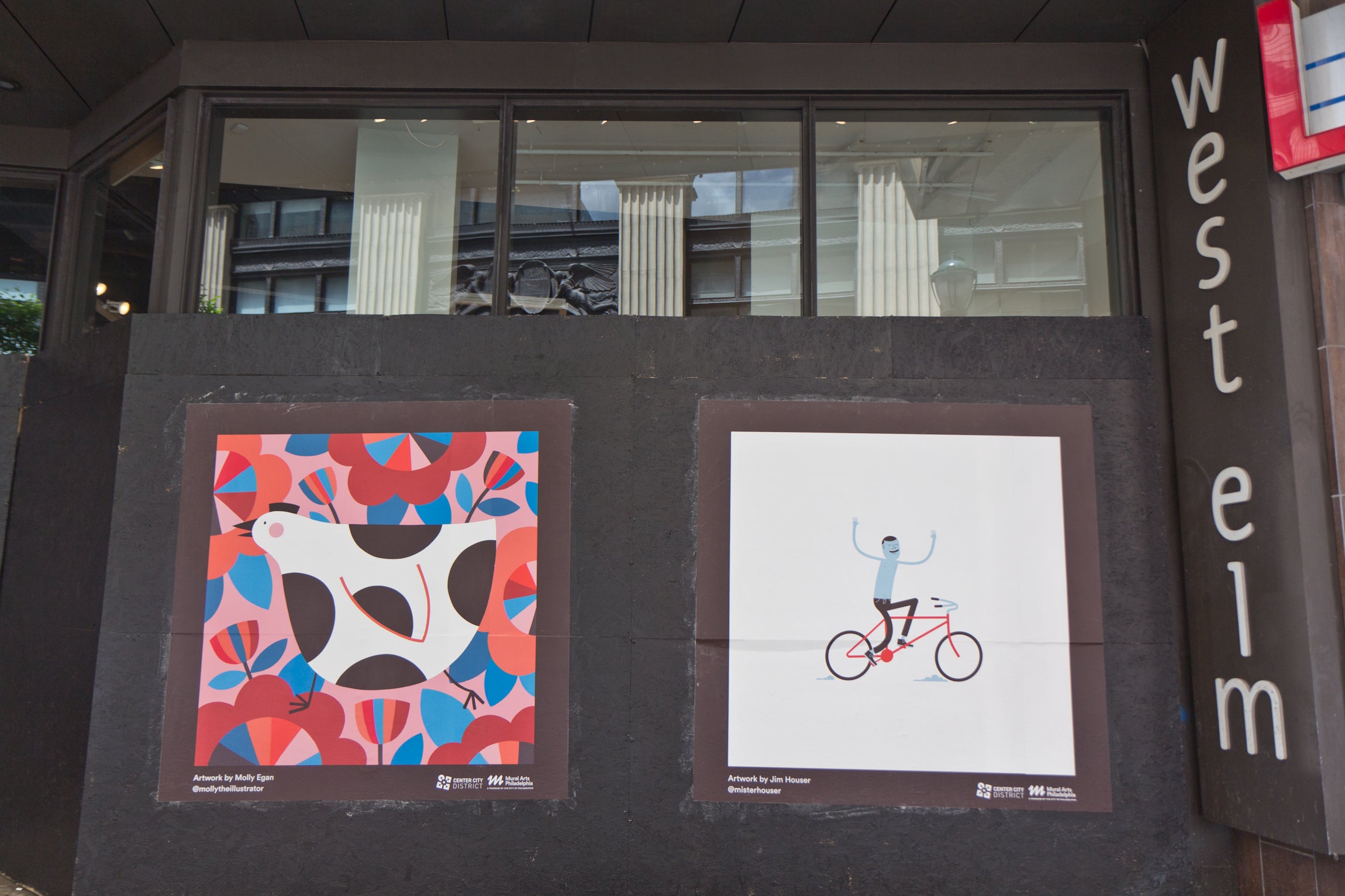
When the pandemic happened and the “world turned upside down,” Golden said she and many others at Mural Arts started to rethink its programming and the way it transforms public spaces.
Its art education program moved online. For its Porchlight Program, they’ve started phone-banking, sending postcards, and created a coloring book for kids grappling with trauma.
But Golden said she and her colleagues also started talking about the ways public art could intersect with public health to assist the city in handling this crisis.
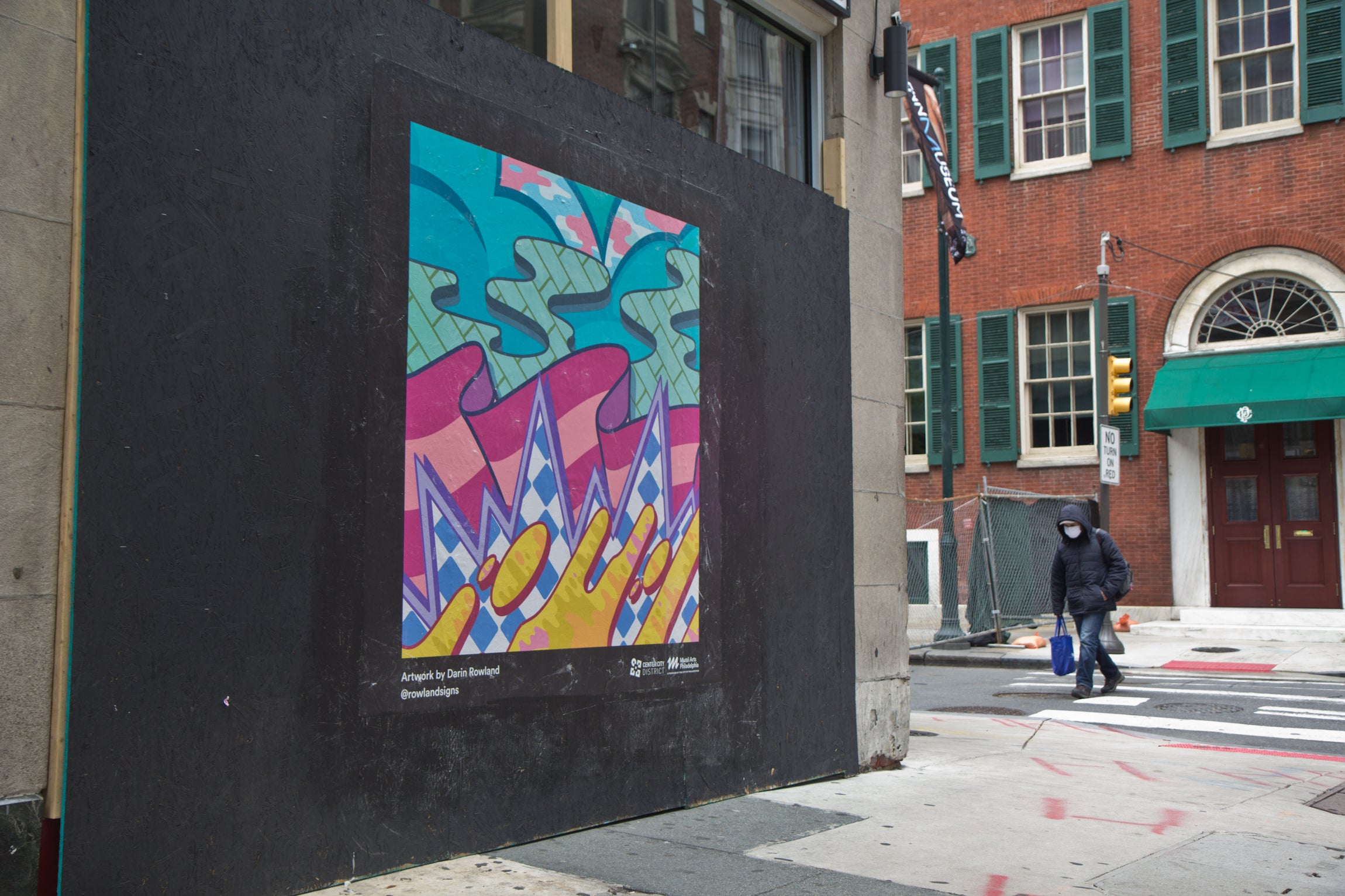
That’s what sparked Mural Arts’ Space Pad program, which has brought more than 2,000 posters and vinyl decals to grocery stores, pharmacies, mini-marts, food distribution sites and other places where people gather to encourage six feet apart, social distancing while waiting in lines.
Since the decals starting popping up in April, Mural Arts has formed a partnership with the city’s Department of Public Health, Broad Street Ministry, Project HOME and Prevention Point to create Space Pads for the Step Up to the Plate initiative, which is helping put the city’s caterers back to work while simultaneously feeding those experiencing food and housing insecurity. They’ve installed 700 decals for the Center City site for the initiative, and 140 at the Kensington site.
The @PHLPublicHealth department partnered with @muralarts to create easy-to-follow and engaging reminders about social distancing.
Look for space pad decals at six Philadelphia Housing Authority locations that are serving as free food sites. Dozens more will be installed soon. pic.twitter.com/XRuIATFWFk
— Jim #StayHomePHL Kenney (@PhillyMayor) May 9, 2020
Mural Arts will also be bringing the decals to six Philadelphia Housing Authority sites that are serving as some of the city’s feeding sites.
They’ve been able to employ hundreds of artists through the Space Pads project, Golden said.
Mural Arts next big thing in the works is the ExtraOrdinary Figures portrait project — which will honor Philly’s frontline and essential workers, as well as everyday people helping their communities during the pandemic.
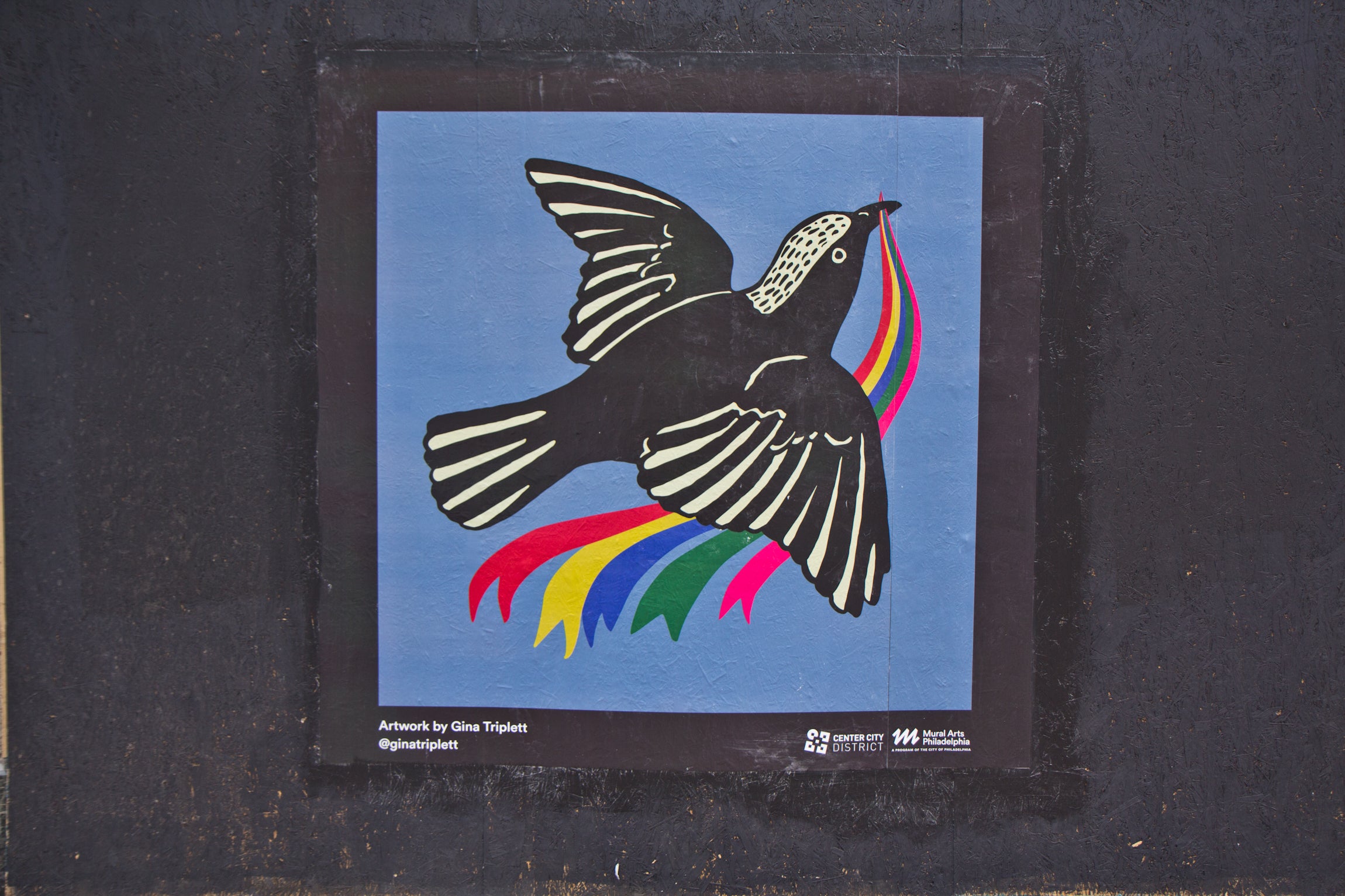
Through May 22, Mural Arts is taking nominations from the public for who should be memorialized. You can submit your recommendation here. Golden said they’ve received 50 submissions as of Wednesday with nominations ranging from people working in homeless services, to grocery store employees to neighbors looking out for seniors on their block.
Once the portraits are complete, they’ll be featured in an online gallery, and eventually, Golden hopes to find a long, low wall to feature all the portraits on publicly, and permanently, in the city.
“I think, at a time like this, what we see is that darkness can overwhelm people and make us stop, or it makes people rise,” Golden said. “And we have seen so many people rise. I think one of the wonderful things about murals … is that they give dignity and respect to people and it’s the dignity and respect that they truly deserve.”
Golden added that Philly residents can expect to see murals being painted this summer even as social distancing guidelines remain in place. She’s confident that artists and crew have the proper safety gear and can install murals while standing six feet apart.
With Mural Arts’ same-day work and pay program Color Me Back, artists will be working on a major mural through a partnership with SEPTA in the underground concourse between City Hall and Walnut-Locust stations.
“It’s giant and cavernous and completely bleak and the design is amazing,” Golden said.
They’ll be starting that project in July.
Golden added that as people are spending more time walking through the city during their pandemic free time, she’s heard through texts and emails that people are viewing Philly’s public art from a different light now.
“We appreciate the color and beauty in a way that it’s almost as if we haven’t seen it before because things are so different from how they were a very short time ago,” Golden said. “So I think, in some way, the art in our city that’s outdoors is grounding. I think it’s a sign that things will eventually be OK, that things will come back, that there will be a sense of normalcy.”

WHYY is one of over 20 news organizations producing Broke in Philly, a collaborative reporting project on solutions to poverty and the city’s push towards economic justice. Follow us at @BrokeInPhilly.
WHYY is your source for fact-based, in-depth journalism and information. As a nonprofit organization, we rely on financial support from readers like you. Please give today.


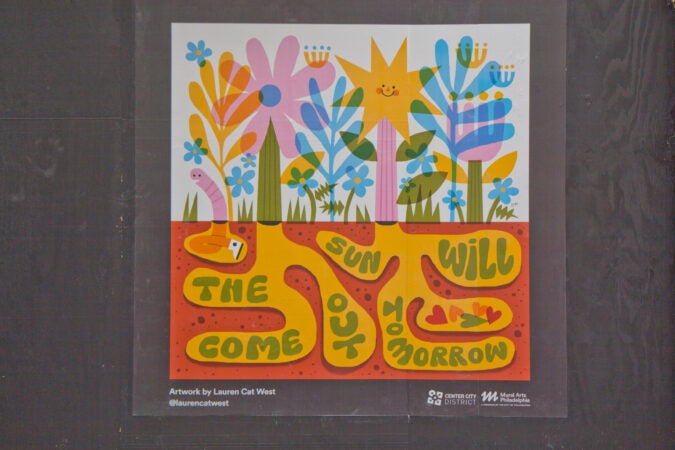


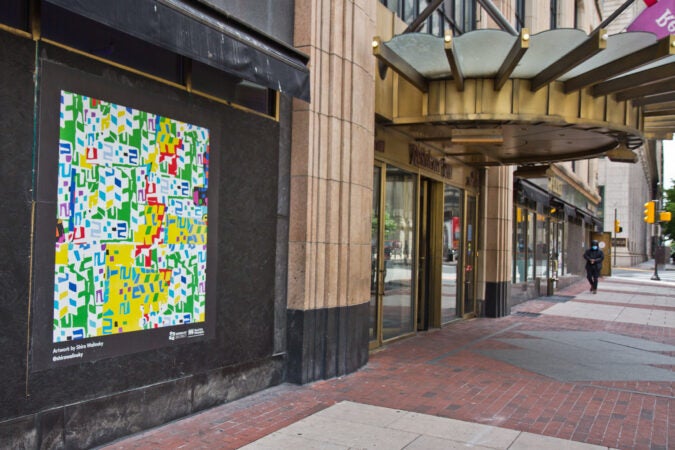
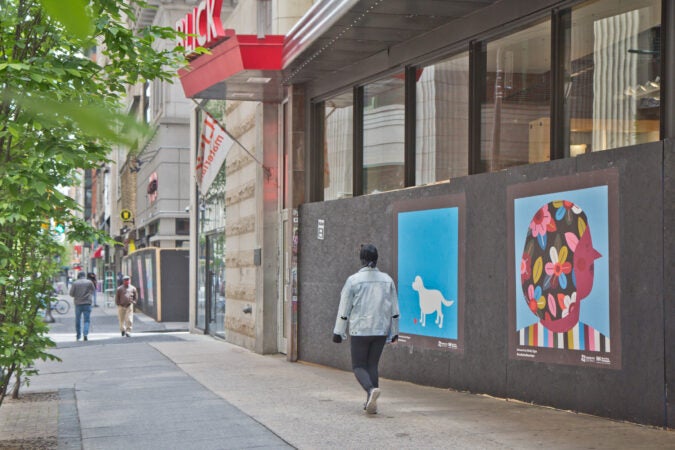
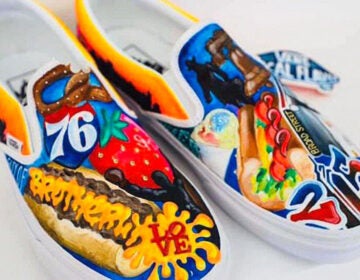
![CoronavirusPandemic_1024x512[1]](https://whyy.org/wp-content/uploads/2020/03/CoronavirusPandemic_1024x5121-300x150.jpg)
